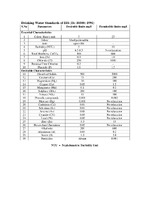Items
Tag
water
-
 WaterQualityStandards The Drinking Water Standards of BIS (IS: 10500: 1991) outline the essential characteristics of drinking water, including color, odor, taste, turbidity, pH, total hardness, iron, chloride, residual free chlorine, fluoride, and pesticides. The water's electrical conductivity is also a crucial factor. The upper permissible safe limit for electrical conductivity in water is μmhos/cm at 25 ̊C. The water's quality is evaluated based on Sodium (Na) % Electrical Conductivity μmhos/cm at 25 ̊C. The water's boron concentration is rated based on the class of water, with a rating of excellent <0.25 < 250 < 10 < 1.25, good 20-40 250-750 10-18 1.25-2.0, medium 40-60 750-2250 18-26 2.0-2.5, bad 60-80 2250-4000 >26 2.5-3.0, and very bad >80 >4000 >26 >3.0. The trace elements tolerance for irrigation waters is also outlined. The maximum tolerance limits for industrial effluents discharged (mg/l) are set for color and odor, suspended solids, pH value, dissolved solids, and temperature ̊C. Pesticides are not allowed in the water.
WaterQualityStandards The Drinking Water Standards of BIS (IS: 10500: 1991) outline the essential characteristics of drinking water, including color, odor, taste, turbidity, pH, total hardness, iron, chloride, residual free chlorine, fluoride, and pesticides. The water's electrical conductivity is also a crucial factor. The upper permissible safe limit for electrical conductivity in water is μmhos/cm at 25 ̊C. The water's quality is evaluated based on Sodium (Na) % Electrical Conductivity μmhos/cm at 25 ̊C. The water's boron concentration is rated based on the class of water, with a rating of excellent <0.25 < 250 < 10 < 1.25, good 20-40 250-750 10-18 1.25-2.0, medium 40-60 750-2250 18-26 2.0-2.5, bad 60-80 2250-4000 >26 2.5-3.0, and very bad >80 >4000 >26 >3.0. The trace elements tolerance for irrigation waters is also outlined. The maximum tolerance limits for industrial effluents discharged (mg/l) are set for color and odor, suspended solids, pH value, dissolved solids, and temperature ̊C. Pesticides are not allowed in the water.